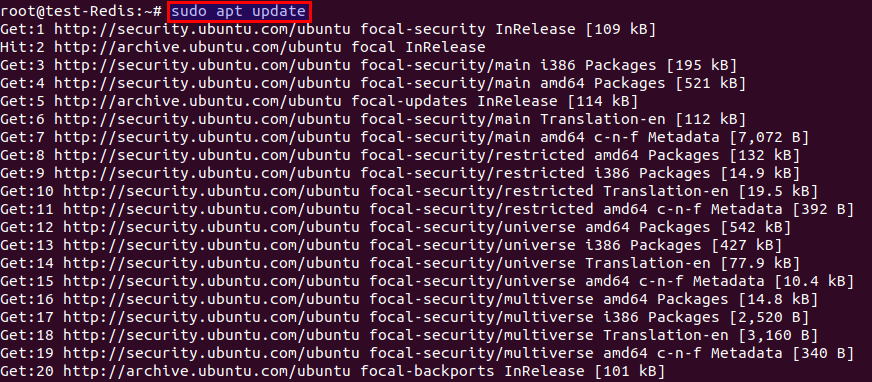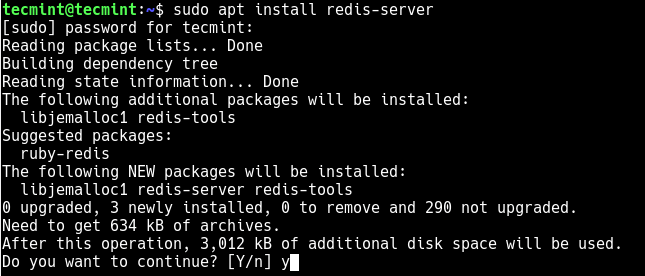

- INSTALL REDIS UBUNTU HOW TO
- INSTALL REDIS UBUNTU INSTALL
- INSTALL REDIS UBUNTU UPDATE
- INSTALL REDIS UBUNTU WINDOWS
The Redis configuration file is long and heavily annotated. For example: sudo emacs -nw /etc/redis/nf Navigate to the Redis configuration file at "/etc/redis/nf" and open it in your favorite text editor. Once the installation process is complete, there's one final step before you can start using Redis.
INSTALL REDIS UBUNTU INSTALL
The command to install Redis is as follows: sudo apt install redis-server
INSTALL REDIS UBUNTU UPDATE
Before getting started, be sure to update your apt package cache: sudo apt update Installing Redis on Ubuntu is a snap - the Redis package is already included in the default Ubuntu repositories.
INSTALL REDIS UBUNTU WINDOWS
That all sounds great - so how do you install Redis in the first place? In this article, we'll go over the steps to install Redis on Windows and Ubuntu Linux, so you'll be up and running in no time. What's more, the 2019 Stack Overflow developer survey found that Redis was the "most loved" database, beating well-known competitors such as Microsoft SQL Server, MongoDB, Oracle, and MySQL. According to the DB-Engines ranking, Redis is the eighth most popular database technology in the world, as well as the most popular key-value database. Today, we saw how our Support Engineers uninstall Redis from Ubuntu without any remnants.Redis is an open-source, in-memory data structure store that is frequently used to implement key-value databases, caches, and message brokers. In short, proper uninstalling of Redis involves removing the dependencies and related data files. rm /var/run/redis_*įinally, we restart the server to completely remove Redis. Later we check for any PID file and remove that too. rm -r /var/lib/redis/įinally, we remove the init scripts. Next, we remove the log files using the command, rm /var/log/redis_* First, we remove the files in /usr/local/bin using the command, rm /usr/local/bin/redis-* Next, we remove the Redis file from the server. Initially, we stop the Redis server, using the command, systemctl stop redis

Let’s see how our Support Engineers do this. Some customers install the Redis by compiling the source package. A server without Redis server shows up as: :~# apt-cache policy redis-server

This command gives the status of the package in the server.

For this, we use the command, apt-cache policy redis-server This successfully uninstalls the Redis from the Ubuntu server.Īfter uninstalling the package, in the Ubuntu system check if the package is present or not. Here -auto-remove option removes the Redis server package and its dependencies.Īnd the purge option removes the configuration and other Redis related data files. So in such cases, we uninstall Redis using the command, apt-get purge -auto-remove redis-server The Ubuntu server install packages with apt-get. So let’s see how our Support Engineers uninstall Redis properly in both cases. The uninstallation process depends on the way the user installs a package.
INSTALL REDIS UBUNTU HOW TO
So let’s see how to completely uninstall the Redis package from the server. So to fix this, we need to completely remove the existing package and then do a complete installation. Usually, this error denotes a redundant package left after removing Redis. In some servers, checking the redis-server status shows up as, So let’s see how our Support Engineers do a complete removal of Redis from an Ubuntu server. Hence, while uninstalling a package its important to remove its dependencies and related data files to avoid further errors. Usually, this happens when there are multiple installations of the same package. This is called installing from the source.Ĭustomers often approach us to uninstall Redis when they got stuck due to improper installation. Whereas, the other way is manually installing Redis using the makefile. One way is the installation from the repository. Its major application is to deliver fast loading websites by enabling caching. Redis aka Remote Dictionary Server is an open-source, in-memory, data structure server. Today, let’s see a brief guide on how our Support Engineers make Redis working. Website performance enhancing tools like Redis can be installed either from the repository or from the source.īut improper uninstallation leaves redundant files and affects the working of Redis.Īt Bobcares, we often get requests to uninstall Redis and reinstall, as a part of our Server Management Services. Are you looking for how to uninstall Redis from Ubuntu? We can help you with it.


 0 kommentar(er)
0 kommentar(er)
